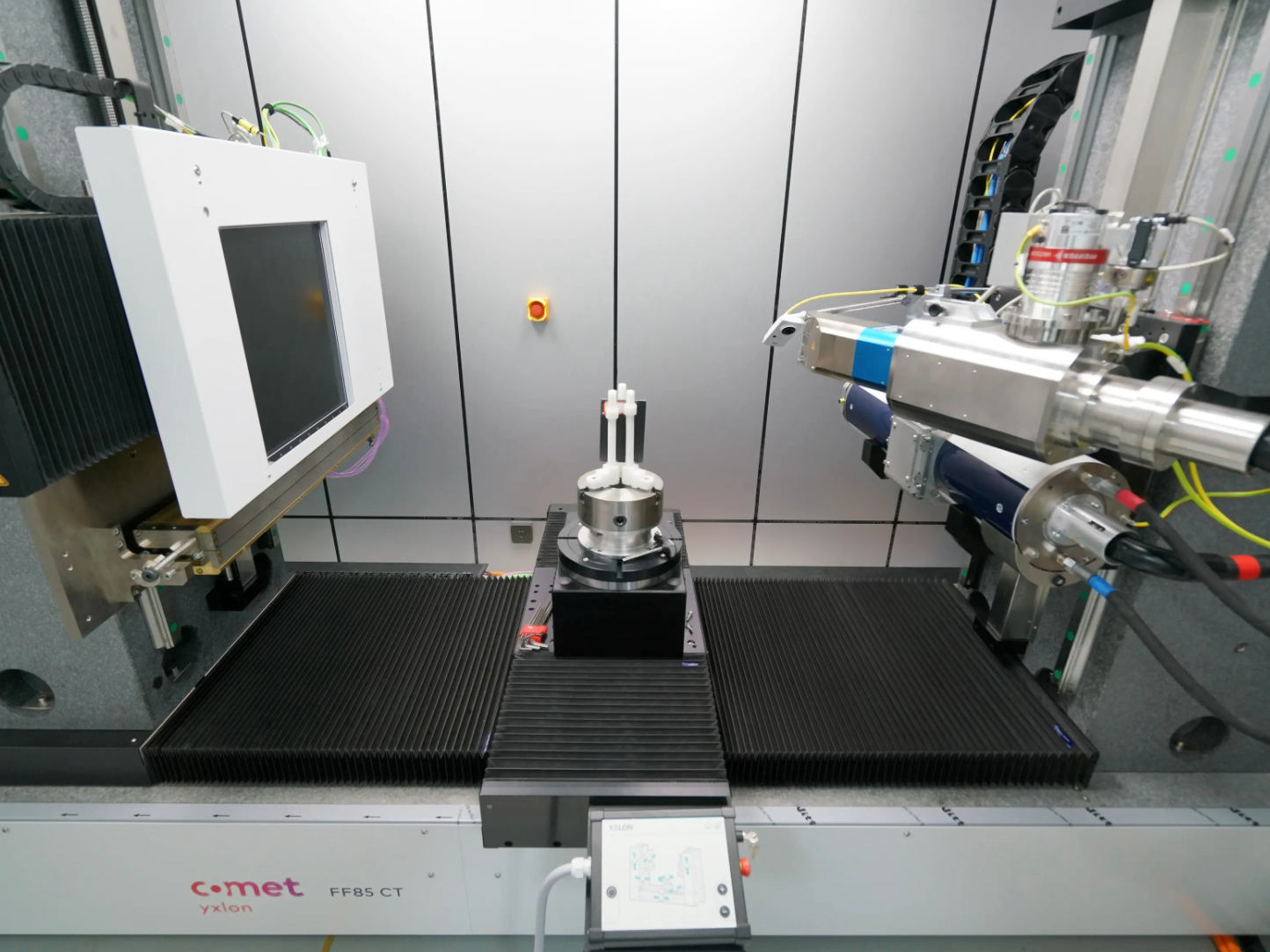Advanced Imaging for Precision: 450KV Line Array Industrial CT in Quality Assurance
Industrial CT: Precision Internal Inspection
In mission-critical manufacturing sectors like aerospace, automotive, and medical devices, sub-100 µm internal defects—undetectable by traditional methods—can lead to catastrophic failures. Neway’s YXLON FF85 CT system combines a 450kV/600W X-ray source and Varex 4343 detector array to achieve <3 µm voxel resolution, enabling full 3D reconstruction of aluminum die castings, titanium aerospace brackets, and multi-material assemblies up to 800 mm diameter.
Technical Specifications & Imaging Protocol
Hardware Configuration
X-ray Source:
450kV closed tube (YXLON MG452)
Tungsten transmission target
Beam divergence: 0.3° (microfocus mode)
Detector:
Varex 4343 Flat Panel (2048×2048 pixels, 200 µm pixel pitch)
Dynamic range: 16-bit (65,536 gray levels)
Manipulator:
5-axis CNC stage (±5 µm positioning accuracy)
Max load: 150 kg
Scanning Protocol (ASTM E1695)
Energy Calibration:
320 kV/380 µA for aluminum (Z=13)
450 kV/420 µA for steel (Z=26)
Filter Optimization:
3 mm Cu + 1 mm Sn for beam hardening correction
Acquisition:
3600 projections at 0.1° increments
3-frame averaging for noise reduction
Reconstruction:
FDK algorithm with GPU acceleration (NVIDIA A6000)
3D model output: 16-bit TIFF stack (DICONDE compliant)
Quantitative Defect Analysis Applications
1. Porosity Mapping in Die Castings
Process:
Scan A380 Aluminum transmission cases (300×200×150 mm) at 250 µm voxel.
Apply VGSTUDIO MAX porosity module (ISO 5011 compliance).
Data:
Detect pores 50–300 µm with 98% confidence.
Reduce die casting scrap rate from 8.2% to 2.7% through gate optimization.
2. Additive Manufacturing Validation
Case:
LPBF-printed Ti-6Al-4V lattice structures (0.2 mm strut diameter).
Results:
Identify 25–80 µm un-melted powder inclusions.
Achieve 100% density via laser power adjustment (+15%, 380W).
3. Composite Bonding Integrity
Application:
Carbon fiber-aluminum hybrid battery enclosures (EV).
Metrics:
Detect 0.1 mm disbonds with edge-enhancement algorithms.
Improve peel strength from 12 N/mm to 18 N/mm.
Comparative Performance Metrics
Parameter | Industrial CT | Micro-CT | X-ray DR |
|---|---|---|---|
Resolution (µm) | 5 | 1 | 100 |
Penetration (mm steel) | 150 | 30 | 80 |
Scan Time (mins) | 15 | 180 | 2 |
Data Volume (GB/scan) | 12–25 | 200–500 | 0.5–2 |
Cost per Scan ($) | 150–300 | 800–1,500 | 50–100 |
Case Study: CT scanning reduced inspection time for Zamak 5 connectors by 70% versus destructive cross-sectioning.
Integration with Smart Manufacturing
1. Automated Defect Recognition (ADR)
Train CNN models (TensorFlow) on 10,000+ defect images.
Achieve 99.3% accuracy in classifying:
Porosity (Type A/B/C per ASTM E505)
Inclusions (Al₂O₃, TiN, etc.)
Geometric deviations (GD&T)
2. Digital Twin Correlation
Compare CT data with FEA simulations to predict fatigue life.
Example: 316L stainless steel valve bodies:
95% correlation between CT-identified voids and FEM stress concentrations.
3. Blockchain Traceability
Embed CT metadata (DICONDE) into Hyperledger Fabric ledger.
Enable FDA UDI compliance for medical implants.
ROI Analysis (2023 Data)
Aerospace:
$1.2M/year saved via pre-NDI crack detection in turbine blades.
Automotive:
40% faster PPAP approval for EV motor housings.
Medical:
Zero field failures in 50,000+ Ti implants since 2021.
Future Trends: AI-Driven CT
Implement real-time reconstruction (NVIDIA Clara) to reduce processing from 15 mins to <2 mins.
Develop multi-energy CT for material decomposition (e.g., Cu/Zn ratios in brass alloys).
Conclusion
Neway’s industrial CT solutions bridge metrology and NDT, delivering µm-level insights from prototyping to serial production. With AS9100D and ISO 13485 certifications, we empower manufacturers to achieve zero-defect ambitions.
FAQs
What is the minimum detectable crack size in titanium alloys?
Can CT systems analyze liquid-filled components?
How are CT results validated against destructive testing?
What training is required to operate industrial CT systems?
Does CT work for ceramic matrix composites?

